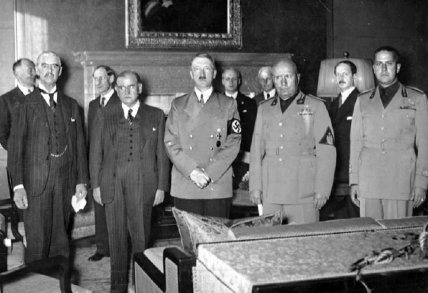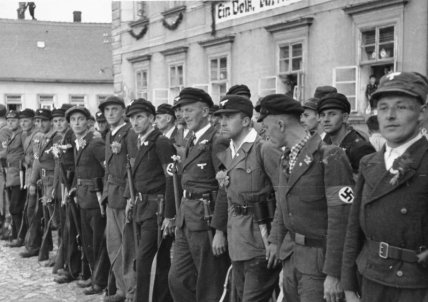How territorial concessions to an aggressor resulted in the ultimate loss of independence: the history of the Czechoslovak crisis of 1938-1939.
History often appears to begin anew, yet it actually follows old patterns. "If Russia pays a small price or pays nothing at all – and it seems that's how it will be – the next target will be Ukraine. Naturally, not all of it, only the Crimean Peninsula". These almost prophetic words from American political scientist Leon Aron (who had not yet included Ukraine's Donbas in the "list" of future Russian aggression) were spoken at the end of August 2008 – right after the swift and victorious war for Russia in Georgia and the signing of an agreement between the West and the Kremlin.
The agreement was named the "Medvedev-Sarkozy" accord after the then-presidents of Russia and France. Russia had no intention of adhering to it. This was a shortsighted act of "appeasing the aggressor". Of course, at the expense of the victims of aggression. Such instances in history are far from rare.
"Kremlin-style coercion to peace"
By the way, Kremlin spokespersons referred to the rapid war in Georgia as an "operation to coerce peace." This operation effectively recorded the actual capitulation of the small Caucasian country and the final establishment of proxy "states", entirely dependent on the Kremlin – Abkhazia and South Ossetia – on its sovereign territory.
What is currently happening in Georgia, which has lost more than 20% of its territory, is a result of that very capitulation. This capitulation led to a shift among the political elite: pro-Russian forces came to power, brutally suppressing protests from citizens following the recent fraudulent parliamentary elections. Meanwhile, the global community failed to learn the lessons from Russia's war against Georgia and continued to look benignly upon the Kremlin's actions.
However, there have been other examples in world history where David did not raise his hands before Goliath. For instance, Finland, which had a population 55 times smaller than that of the Soviet Union, managed to withstand the "peaceful" neighbor's attack during the Winter War of 1939-1940 with honor. Despite the overwhelming superiority in virtually every aspect, Soviet troops achieved success only after 3.5 months, finally overcoming the "Mannerheim Line". But the horrifying losses (which exceeded Finnish casualties by six times) and the severely damaged image in the world compelled Joseph Stalin to sign a peace treaty. Despite losing 10% of its territory, Finland, led by its uncompromising leader Carl Gustav Mannerheim, retained its independence and did not become a "Soviet" republic.
Are there currently leaders in Western democracies akin to British Winston Churchill, Mannerheim, or Polish Józef Piłsudski? Even during Barack Obama's second term as President of the United States in late winter 2014, the collective West (primarily the world's most powerful military and economic power – the USA) had a chance to stop the bloody aggressor. However, there have long been no lofty and powerful leaders across the ocean or in the Old World – and that is a regrettable fact. Barack Obama (two terms!), Donald Trump, former Vice President under Obama Joseph Biden (far from the worst option), and once again completely unpredictable Trump. Congratulations to the Americans! And to the entire world. Which is confidently marching toward World War III. To be precise, it has actually already begun…
Ukraine was supposed to follow the path of Czechoslovakia from 1938-1939 as early as late February 2022. And again under the applause of peacemakers from democratic Western nations. Something didn’t pan out – for both the aggressor and the democratic countries that were already ready to sacrifice the Ukrainian state to Putin.
Deferred capitulation as a death sentence
…On the night of September 30, 1938, the Chancellor of Nazi Germany Adolf Hitler, the Duce of Fascist Italy Benito Mussolini, and the heads of government of Great Britain, Neville Chamberlain, and France, Édouard Daladier, signed a document that turned out to be not a peace treaty but a deferred capitulation, a death sentence for one of the most democratic countries in Europe – the Czechoslovak Republic. Its leaders were not even invited to the negotiations in Bavaria's capital. Winston Churchill, an implacable enemy of the Nazis and one of the few British politicians who predicted the catastrophic consequences of Munich '38, said in the House of Commons on October 3 that year: "England was offered a choice between war and dishonor. It chose dishonor and shall have war."
 7
7 Was Stalin's Kremlin really prepared to help Prague? This question continues to spark debates among historians. In my opinion, Stalin had no intention of fulfilling his obligations under the 1935 Soviet-Czechoslovak treaty. He was more interested in inflaming the flames of military conflict in Europe between democratic countries and the block of totalitarian states. Later, he aimed to bleed them dry and then intervene to dictate terms from a position of strength. The entire subsequent policy of the Soviet Union up to June 22, 1941, confirms this thesis. After the signing of the Ribbentrop-Molotov Pact for the dismemberment by two predators – the Nazis and communists – of the Second Polish Republic, there was an unsuccessful attempt to seize all of Finland during the Winter War, a seamless occupation of the three Baltic states, and parts of Romania (Bessarabia and Southern Bukovina).
One of the main problems of the Czechoslovak Republic was the presence of a large (over 22%) and restless German national minority, which lived compactly along the borders with Germany and Austria (by that time, the "Anschluss" – the absorption of this republic by the Nazis – had already taken place). On the evening of September 12, 1938, Hitler broadcast on the radio, accusing Czechoslovakia of torturing and suppressing the German minority. Violence against Czechs, Jews, and anti-fascist Germans had already raged for several days across the entire border area. The Czechoslovak army and border guards managed to suppress this coup. Meanwhile, the Western press largely published sympathetic articles about the Sudeten Germans. The governments of Western nations feared a repeat of the horrors of the First World War. However, they soon faced the Second World War...
Paris and London had definitively dashed the hopes of allied Prague for assistance as early as August 1938. An unofficial mission by British Lord Walter Rensselaer took place then, where he diligently twisted the arms of Prague officials and politely listened to delegations from the Sudeten Germans for hours (at that time, the pro-Nazi Sudeten German Party led by Konrad Henlein, which had the largest faction in the capital's parliament, was supported by over 85% of its compatriots).
Such were the "allies" of the Prague government: they recommended through Rensselaer the "transfer of regions with predominantly German populations" to Germany… On September 19, 1938, the British and French governments sent an ultimatum note insisting on the "liberation" of those areas where Germans made up over 50% of the population.
 8
8 Was there an alternative to capitulation? The armed forces of Czechoslovakia numbered up to two million people. There were a total of 45 divisions (of which 38 were fully staffed), 469 tanks, 5700 artillery pieces and mortars, and 1582 aircraft. 37 of the 45 divisions were stationed near the borders with Germany.
 9
9 Virtually all infantry units were motorized; the army possessed ultra-modern weapons. The powerful personnel potential – trained reserves – could have become an important asset (due to the Versailles articles, the Germans did not have such reserves).
 0
0 On the global arms market, Czechoslovakia was the main (!) player, accounting for nearly 40% of supplies. The line of defensive structures along the borders was unparalleled on the planet. The French "Maginot Line" and the German "Siegfried Line" were significantly less powerful. In 1969, former Nazi Germany's Minister of Armaments Albert Speer wrote: "The Czech border fortifications caused general astonishment… Hitler personally went to the old border to get an impression of these fortifications and returned overwhelmed. The bunkers were very powerful, exceptionally well-placed, deeply layered with excellent use of the terrain. Their capture, with determined defense, would cost us a lot of blood."
 1
1 The Germans concentrated 39 divisions on the borders with Czechoslovakia. In total, they had 47 divisions and 2.2 million men in the Wehrmacht by September 1938. The French, on the eastern border, had at least 60 first-line divisions, which were met by only under-strength 13 landwehr divisions with a complete absence of armored troops. The allies had more than a twofold advantage in the event of a two-front war! And this does not even account for British